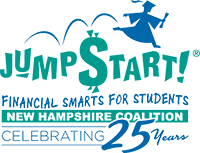At New Hampshire Jump$tart, we recognize that teachers are a valuable resource to reach children. Since August 2000, we have focused much of our efforts in identifying resources and partnerships for teachers that will assist them in sharing personal finance concepts with their students.
- Here you will find access to the National Jump$tart Coalition’s Clearinghouse of high-quality personal finance materials for educational use. The Clearinghouse is a database of personal finance resources available from a variety of education providers such as government, business and non-profit organizations. Many of the materials are low cost or free of charge. Teachers often use these personal finance teaching materials to support their state’s standards in economics, business, math and family and consumer science.
- We also have partnerships and collaborations with many other curriculum and program providers. Contact us for specific recommendations.
- Since our beginning, our professional development conference for teachers has become widely known as a substantive educational event for Granite State teachers in the area of personal finance. Now called Classroom Connections, watch for details on the conference which is held every May.
- FinLit300 is a unique educational experience for students in grades 9-12. Teachers prepare teams of students to compete in a game-show environment that covers topics in personal finance in alignment with the Jump$tart National Standards in K-12 Personal Finance Education.
- The “I Can Save!” Tour is designed to teach second graders the importance of saving at an early age. Students are given a Centsables™ moneybox that encourages children to “Save, Spend & Share”.
- Have your students taken the Reality Check yet? It’s a fun tool to help them to figure out how they can live on their own! Want us to come to your classroom and give them a reality check? Request a visit today!
- The 2015 edition of the National Standards in K-12 Personal Finance Education is published by the Jump$tart Coalition for Personal Financial Literacy on behalf of its partners—from business, finance, government, academia, education, associations and other sectors—and its 50 independent state affiliates.
